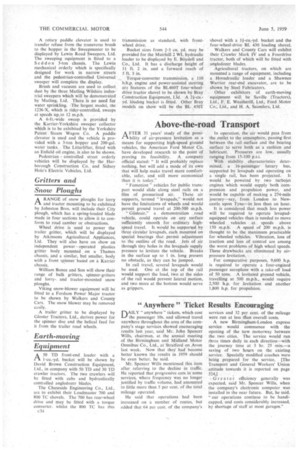Above-the-road Transport
Page 76

If you've noticed an error in this article please click here to report it so we can fix it.
FTER 31 years' study of the possii—k bility of air-pressure levitationas a means for supporting high-speed ground vehicles, the American Ford Motor Co. have developed research to the point of proving its feasibility. A company official stated: " .It will probably replace nothing, but will add a mode of its own that will help make travel more comfortable, safer, and, still more economical than it is today."
" Fomotion " vehicles for public transport would slide along steel rails on a film of pressurized air. These air supports, termed "levapads," would not have the limitations of wheels and would permit ground travel at 200-500 m.p.h.
Glideair," a demonstration road vehicle, could operate on any surface sufficiently smooth for ordinary highspeed travel. It. would be, supported by three circular levapads, each mounted on special bearings that-. permit adjustment to the outline of the road. 'Jets of air through tiny holes in the levapads supply pressure to levitate the vehicle. Breaks in the surface up to 1 in. long present no obstacle, as they can be jumped.
In 'rail travel, several levapads would he used. One at the top of the fail Would support the load, two at the sides of the rail would prevent lateral motion, and two more at the bottom would serve as grippers. In operation, the air would pass from the outlet to the atmosphere, passing first between the rail surface and the bearing surface to serve both as a cushion and lubricant. Pressures are low, usually ranging from 15-100 p.s.i.
With stability characteristics determined, a 16-passenger luxury bus, supported by levapads and operating on a single rail, has been projected. It would be powered by two turbojet engines which would supply both compression and propulsion power, and would be capable of making a 274-mile journey—say, from London to Newcastle upon Tyne—in less than an hour. . It is considered that much less power will be required to operate levapadequipped vehicles than is needed to move wheeled vehicles at . speeds above 150 m.p.h. A speed of 200 m.p.h. is thought to be the maximum practicable for wheeled vehicles. Vibration, loss of traction and loss of control are among the worst problems of high wheel speeds. These drawbacks are eliminated by airpressure levitation.
For comparative purposes, 9,600 h.p. is required to operate a four-engined passenger aeroplane with a take-off load of 50 tons. A levitated ground vehicle, travelling at 500 m.p.h.,. would require 2,500 h.p. -for levitation and another 1,800 h.p. for propulsion.




































































































































